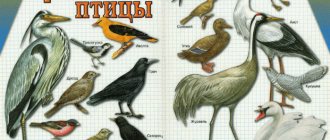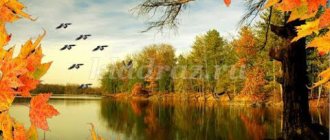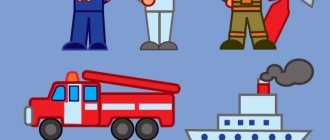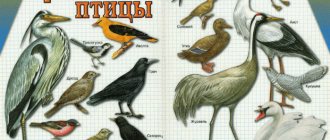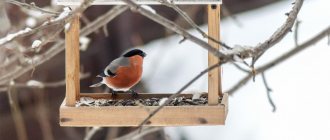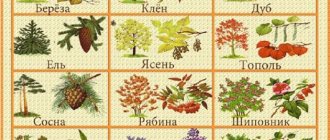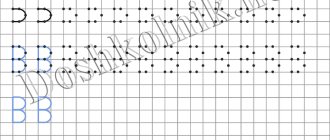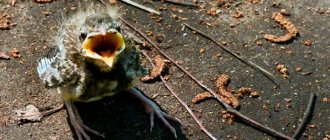Summary of a subgroup lesson on the topic: “Migratory birds”
Subgroup lesson
Educational institution: MBDOU No. 104
Teacher speech therapist
(Full name) Tkalicheva Galina Vladimirovna
The date of the:
Children according to the structure of speech impairment:
FFNR.
Children's age
: 5-6 years.
Subject
“Birds of Migratory”
Correctional educational goals:
to teach children to form and use prefixed verbs and various prepositions;
Corrective and developmental goals:
develop the ability to compose simple sentences; — exercise children in the formation of nouns with a diminutive meaning;
— consolidate the ability to coordinate nouns with numerals. Correctional and educational goals:
instill in children curiosity about the world around them;
— to cultivate in children an interest in the behavior of feathered inhabitants of nature, a caring attitude towards them.
Planned results
(targets):
Able to coordinate nouns with numerals
Children select adjectives for nouns.
Form and use prefixed verbs and various prepositions.
Make up simple sentences.
Equipment:
a model of a birdhouse and feeder, object pictures depicting migratory birds, a starling and a swallow cut out along the contour of cardboard.
Progress of the lesson.
I
Org. moment. (2-3 min.) Game “fourth wheel”
Crow, sparrow, swallow, dove.
- Guys, tell me which bird is the odd one out? (martin)
II
Main part.
(25 min) Announcement of the topic.
— Today in class we will talk about migratory birds. Listen carefully to the story.
Birds.
Wherever you walk - along the seashore, in a village or in a city park - you will meet birds everywhere. Almost all of them can fly. Birds are animals with feathers and wings. Feathers help retain heat and give birds their unique colors. Birds often preen themselves, that is, they clean their feathers where new ones grow.
Birds live in nests. They usually build nests from leaves, twigs and grass, but some birds live in piles of stones. The female lays eggs and then incubates them, warming them with her warmth until they hatch and the chicks hatch. In autumn, migratory birds gather in flocks and fly south to spend the winter there. And when the winter frosts end, they will return.
Did/game “Where is the bird?”
—
Guys, tell me where the swallow is now? (in the feeder, on the table, on the head)
- Where did the swallow fly from? (from the shoulder, from the window)
- Where did the starling fly out of? (from the feeder)
-What did the starling fly up to? (to the table, to the feeding trough)
— The starling flew away from what? (From the table, from the feeding trough)
Swallow and starling are sitting under what? (under the roof, under the table)
Article:
Goal: to consolidate students’ knowledge about spring and spring signs.
Tasks:
Educational:
- continue to teach students to form the genitive case of plural nouns
- develop the ability to coordinate words in a sentence, correctly use prepositions in speech
- improve students’ skills to participate in dialogue, answer questions with complete answers
- enrich students’ vocabulary on the topics “Migratory Birds” , “Wild Animals” , “Insects”
- consolidate the skills of correct pronunciation of sounds [Z], [Zh], [C].
Educational:
- develop phonemic awareness in students
- develop gross motor skills, coordination of speech and movement
- develop memory, auditory attention.
Educational:
- cultivate a caring attitude towards nature and a friendly attitude towards each other.
Preliminary work:
Watching birds, trees, melting snow; conversation about spring; asking riddles about animals, plants, birds, insects; reading poems about spring.
Methods and techniques:
Dynamic exercise “On the paths...” , questions to the students, answers from the students, reading a poem by the student, reciting a simple phrase, physical education, didactic game “One - Many” , musical and rhythmic composition “Exercising funny animals” . Music by M. Eremeeva, lyrics by S. Eremeev, listening to the audio recording “Voices of Birds” , performance of the song “Spring Tale” music by T.A Simakova, lyrics by A.S. Shalamonov using children's musical instruments) analysis of the work of pupils by the teacher, self-analysis by the pupils.
Materials and equipment:
- interactive device
- laptop
- music Center
- audio recording “Sounds of nature”
- a tray with suns and a tray with clouds
- musical instruments
- animal masks and caps.
Vocabulary work: demi-season clothing, hibernate.
Motivation: personal interest.
Part I
(pupils enter the hall to the music and stand near the chairs). Speech therapist: Children, today we will take a walk in the spring forest. We will see a lot of interesting things in the forest.
1. Dynamic exercise “Along the paths...”
Speech therapist: I invite you to go for a walk in the spring forest. Guys, we can't find more interesting adventures
Stand next to each other, hold hands tightly. (pronounced together with the teacher) Along the paths, along the paths
Let's go for a walk in the forest. Maybe in the spring forest we will find someone. (pupils take each other’s hands and follow the teacher in a round dance step, “snake” (they approach the chairs, sit down)).
(The curtain opens)
Speech therapist: We came with you to the forest. Slide No. 1
Pupil: (reads a poem)
Hello, forest, dense forest, Full of fairy tales and miracles. Who is hiding in your wilderness? What kind of animal, what kind of bird?
Open everything - don’t hide it. You know, we are our own.
Part II.
Speech therapist: Children, tell me what time of year it is now?
Pupils' answers. (Now the time of year is spring)
Speech therapist: Name the signs of spring.
Pupils' answers: - the snow is melting, streams are flowing;
- the sun is shining brighter
- birds fly in and build nests
- insects appear
- animals wake up after hibernation
- small buds and tender leaves appear on trees and shrubs
- the first spring flowers appear
- people put on spring clothes.
Speech therapist: Well done, you correctly named the signs of spring. It is so quiet in the forest that the inhabitants of the forest cannot be seen or heard. I suggest you wake them up. Do you agree?
Pupils' answers: (Yes)
Speech therapist: We will wake up the insects first.
First, let's wake up the mosquitoes. Sing the little mosquito's song.
Pupils: (sing the song of a little mosquito: z-z-z-z-z). Slide number 2
Speech therapist: Now the song of a big mosquito.
Pupils: (singing the song of a big mosquito: Z-Z-Z-Z). Slide number 3
Speech therapist: Well done! How beautifully you sang.
Now let's wake up the beetle.
Sing the big bug's song.
Pupils: (singing the song of a big beetle: Zh-Zh-Zh-Zh). Slide number 4
Speech therapist: And now the little bug’s song.
Pupils: (sing the song of a little bug: w-w-w-w) Slide number 5
Speech therapist: We will also wake up the grasshopper. I suggest
chirp like grasshoppers.
Pupils: (chirp like grasshoppers: tsika-tsika-tsika). Slide number 6
Speech therapist: Name the insects that we woke up?
Pupils' answers: (We woke up a mosquito, a beetle, a grasshopper).
Speech therapist: Tell me what other insects you know that live in the forest?
Pupils' answers: (bee, wasp, fly, etc.) Speech therapist: Correct. But in addition to them, animals live in the forest. Look at the screen. Name the animals. Slide No. 7 Pupils’ answers: (bear, fox, hare, hedgehog, elk, wolf, squirrel).
Speech therapist: What animals are these? Pupils' answers: (these are wild animals)
Speech therapist: Why are these animals called wild?
Pupils' answers.
Speech therapist: Name the animals that hibernate? Pupils' answers: (bear, hedgehog, badger, snakes, frogs, lizards).
Speech therapist: I propose to conduct a musical warm-up “Charging funny animals” .
(pupils get up from their chairs, put on hats, stand in a circle)
The musical and rhythmic composition “Charging the Merry Animals” . Music by M. Eremeeva, lyrics by S. Eremeev
Speech therapist: Which animals woke up after hibernation?
Pupils' answers: (we woke up the bear(s), hedgehog(s), snake(s), badger(s), frog(s) or woke up.
Speech therapist: Children, what a great fellow you are for waking up the animals.
(audio recording of birds' voices sounds)
Speech therapist: Children, what did you hear?
Pupils' answers: (we hear the voices of birds)
Speech therapist: Look at the screen. Slide number 8
Name the birds you see on the screen.
Pupils' answers: (rook, swallow, nightingale, starling, cuckoo).
Speech therapist: What kind of birds are these?
Pupils' answers: (these birds are migratory).
Speech therapist: I suggest playing the game “One - Many”
In order for us to start the game, we need to unanimously say to everyone: “ra-ra-ra the game begins”
Speech therapist: Look at the screen. Slide number 9 One nightingale, many...?
Pupils' answers: (nightingales). Slide No. 10
Speech therapist: How many rooks do you see on the screen?
Pupils' answers: (I see one rook). Slide No. 11
Speech therapist: How many rooks are there now? Slide number 12
Pupils' answers: (Now I see a lot of rooks)?
Speech therapist: Look at the screen. One starling, many...? Slide number 13
Pupils' answers: (starlings). Slide number 14
Speech therapist:. One cuckoo, many...? Slide number 15
Pupils' answers: (cuckoos). Slide No. 16
Speech therapist: One swallow, many...? Slide number 17
Pupils' answers: (swallows). Slide No. 18
(audio recording of insects, birds: migratory)
Speech therapist: Well done! You named the birds correctly. Tell me, what kind of birds are these?
Pupils' answers: (These birds are migratory; we named migratory birds). Speech therapist: Well done! Now I propose to please all the inhabitants of the forest with a “Spring Tale” .
Performance of the song “Spring Tale” music by T.A Simakova lyrics by A.S. Shalamonov using children's musical instruments)
(Pupils take instruments, perform a song, after performing the song
put down the tools and stand in a circle).
Speech therapist: Children, you are so great. They sang loudly and played musical instruments rhythmically. How pleasant it is to be in such a beautiful spring forest. But it's time for us to return to kindergarten.
To return to kindergarten, you need to say the words with your eyes closed. Listen. (One, two, three, turn around and you will find yourself in kindergarten).
We open our eyes.
(the teacher and students repeat the words)
(The curtain closes)
Part III.
Speech therapist: Open your eyes. We are back in kindergarten. Where we were?
Pupils' answers: (We were in the forest) Speech therapist: Who did we wake up in the forest?
Pupils' answers: (we woke up the insects). Speech therapist: Name them?
Speech therapist: Who else was woken up? Pupils' answers: (list animals).
Speech therapist: What are the names of the birds that come to us in the spring?
Pupils' answers: (These birds are called migratory).
Speech therapist: Children, if you liked it in the forest, if you played well, then take the sun. If you didn’t like walking in the forest and playing, then take a cloud.
(Pupils take the sun or a cloud).
Speech therapist: Children, I invite you to join the group.
Progress of the lesson
I. Org. moment.
Speech therapist:
Hello guys! Please determine the 3rd sound in the word hello and the 1st sound in the word guys.
Students:
In the word hello the 3rd sound is “R”. In the word guys the 1st sound is “R”.
Speech therapist:
Today in class we will solve riddles and reinforce the sounds “R” and “R”.
II. Guessing riddles. Topic of the lesson.
1. But you will find out what else we will talk about if you guess the riddles.
The 1st student makes a riddle, clearly pronouncing the sounds “R” and “R” (checking homework):
It gets light early in the morning, there are thawed patches here and there. The stream roars like a waterfall. Starlings fly to the birdhouse. Drops are ringing under the roofs. The bear got up from the spruce tree. The sun caresses everyone warmly. Who knows this time of year?
Students:
This time of year is spring.
The 2nd student makes a riddle, clearly pronouncing the sounds “R” and “R” (checking homework):
The spider dreams of Miracle Yudo on a branch at night: A long beak and two wings... If it flies, things are bad! Who is the spider afraid of? Did you guess it? This …
Students:
This is a bird.
Speech therapist:
Today in class we will talk about spring and birds.
2. The “blue bird of luck” flew to us.
There is a belief that if you catch it, you will have good luck in everything. Please name the body parts of the bird.
Students:
A bird has: a head, a body, a tail, wings, eyes, a beak, feathers, paws, and claws.
Speech therapist:
What is a baby bird called?
Student:
A baby bird is called a chick.
3. Game “Big - small” with throwing the ball.
Head - head, eyes - eyes, beak - beak, feather - feather, tail - tail, wings - wings, paws - paws.
III. Migratory birds.
1. Conversation based on questions from a speech therapist.
Speech therapist:
What do birds do in spring? Do all birds return to us from warm regions in the spring? What are the names of the birds that return to us from warm regions in the spring? Name the migratory birds that you know (by chain).
The speech therapist displays pictures of birds that students name (if any). Then the speech therapist adds a few more pictures, naming them, including “sparrow”.
2. Game: “Who’s the odd one out?”
Speech therapist:
Remove the extra picture and explain why you think it is unnecessary?
Students:
An extra sparrow, because it is not a migratory bird, but a wintering bird.
Speech therapist:
That's right, well done! Now, please, select pictures of birds whose names contain the sound “R” or “R”.
Students choose pictures that depict: starling, wagtail, rook, lark.
Speech therapist:
That's right, well done! So, they come to us in the spring. Let's show how they flew.
3. Exercise for fine motor skills: “Birds”
The birds flew (“Birds” - palms towards themselves, crossing their thumbs), they waved their wings (wave their palms). They sat on the trees (“Trees” – palms with widely spaced fingers), and rested together. ("Birds")
4. Speech therapist: Now the guys will tell you riddles
, and you try to guess them, just listen to the end (checking your homework):
The 3rd student asks a riddle, clearly pronouncing the sound “R”:
Black, agile, shouts “krak” - the enemy of worms.
The 4th student asks a riddle, clearly pronouncing the sound “R”:
You recognize him immediately: white-billed, black-eyed, he walks importantly behind the plow, finds worms and beetles. A faithful guardian and friend of the fields, the first messenger of warm days.
Students:
These riddles are about the rook.
Speech therapist:
The riddle describes a rook. What is he like?
Students:
White-billed, black-eyed rook.
Speech therapist:
If you compare the size of a sparrow, a rook and a heron, what is a rook?
Students:
The rook is smaller than the heron, but larger than the sparrow.
5. Formation of possessive adjectives.
Speech therapist:
Whose head does the rook have? tail? wing? feathers? beak?
Students (in a chain with the ball thrown): The rook has a rook’s head. The rook has a rook's tail. The rook has a rook's wing. The rook has rook feathers. The rook has a rook's beak.
Speech therapist:
Please select a diagram of the word rook and explain why you chose it.
There are several sound schemes to choose from:
Students:
The second scheme is suitable for the word rook, because this word has one syllable, four sounds: G - a hard voiced consonant sound, P - a hard voiced consonant sound, A - a vowel sound, Ch - a soft voiceless consonant sound.
Speech therapist:
Right.
6. Formation of related words from the word rook:
- Rook chick(s) – rook, rook
- Their mother is a rook
- Their nests are rooks
- Cluster of nests - rookery (a card with the word rookery is displayed)
7. Agreement of the numeral with the noun.
Speech therapist:
Here is a painting by A.K. Savrasov “The rooks have arrived.” Try to count how many rooks you see.
Students:
One rook, two rooks, three rooks, four rooks, five rooks, six rooks, seven rooks, eight rooks, nine rooks, ten rooks. ...
Speech therapist:
Enough. In a word, let’s say that a lot of rooks have arrived.
IV. Speech therapist reading the story “The Rooks Discovered Spring”
against the background of a painting by A.K. Savrasov “The Rooks Have Arrived” without any emphasis on memorization and retelling.
Rooks are migratory birds, but they winter not in hot countries, but near their native places, because they are not afraid of frost. Their dense plumage protects them from the cold. They fly in search of food. And the rooks are the first to return from wintering, as soon as the snow begins to melt. With loud and joyful deafening cries of “gra-gra-gra”, rooks inspect old nests, repair them and build new ones, several nests on one tree. They set up their rookery in parks, groves, squares, building up all the tops of the trees. Rooks are the most friendly and sociable birds. Together they build nests, together they protect their homes from enemies, be it a cat or a large bird of prey. The whole flock of rooks, with loud cries, swoops down on the enemy, pecking and pinching him until they send him into shameful flight. Rooks are smart and understanding, they imitate well different sounds, the singing of other birds, and the voices of some animals. They are very useful to humans, as they destroy plant pests in fields and vegetable gardens, forests and gardens. Rooks eat beetles, larvae, and exterminate field mice.
Conversation on content.
- Where do rooks winter?
- Which birds return first in the spring?
- When do the rooks return?
- How do rooks build nests?
- How do rooks arrange their rookery?
- How do rooks protect their homes?
- What do rooks eat?
- What benefits do rooks bring?
V. Physical exercise.
Hands raised and waved - These are trees in the forest. Elbows bent, hands shaken - The wind knocks down the dew. We wave our hands smoothly - the birds are flying towards us. We'll show you how they sit down. The wings are folded back.
VI. Repeated reading by a speech therapist of the story “The Rooks Discovered Spring” with a focus on memorization and retelling.
VII. Retelling in a chain according to the drawn up plan, clearly pronouncing the sounds “R” and “R”.
- How do rooks winter?
- Where and how are houses built?
- How do rooks behave in a rookery?
- What do rooks eat?
- What benefits do rooks bring?
